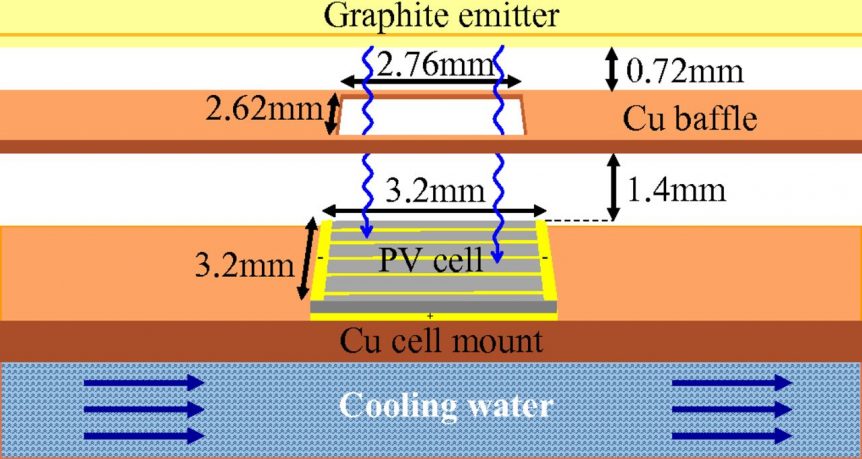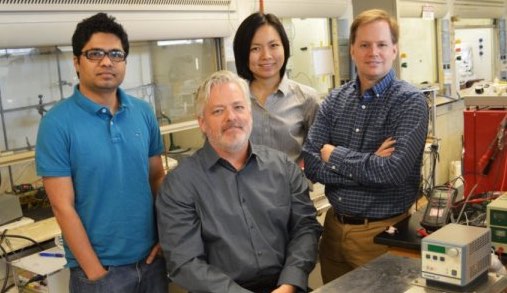Researchers at University of California at Berkeley announced a record in thermophotovoltaic efficiency, now at 29 percent, but with a few tweaks, soon to be at 50 percent. This is great news for small drones, which could stay up for days, but possibly not a be-all, end-all for larger, more conventional electric aircraft. Let’s examine the potential and the pitfalls involved. The researchers’ “groundbreaking physical insight” and “novel design” applies thermophotovoltaic principles that are “an ultralight alternative power source.” Eli Yablonovitch, professor of electrical engineering and computer science (EECS), wrote in a paper published in the Proceedings of the National Academy of Sciences, ““Thermophotovoltaics are compact and extremely efficient for a wide range of applications, from those that require as little as 100 watts, [such as] a lightweight unmanned aerial vehicle, to 100 megawatts, [providing] electricity for 36,000 homes. In comparison, a 100-megawatt combined cycle power plant is massive,” Expanding on work he and his students published in 2011, Yablonovitch …
One step to Liquid Hydrocarbon Fuels from Thin Air
University of Texas at Arlington chemists and engineers have converted carbon dioxide and water directly into useable liquid hydrocarbon fuels – in one step. The “simple and inexpensive new sustainable fuels technology” used concentrated sunlight, high pressure and heat to remove CO2 from the air and even revert oxygen back into the system. Researchers demonstrated that a one-step conversion of carbon dioxide and water into liquid hydrocarbons and oxygen can be performed in a photothermochemical flow reactor operating at 180 to 200 degrees C and pressures up to six atmospheres. Brian Dennis, UTA professor of mechanical and aerospace engineering and co-principal investigator of the project, explains, “We are the first to use both light and heat to synthesize liquid hydrocarbons in a single stage reactor from carbon dioxide and water. Concentrated light drives the photochemical reaction, which generates high-energy intermediates and heat to drive thermochemical carbon-chain-forming reactions, thus producing hydrocarbons in a single-step process.” Frederick MacDonnell, UTA’s interim chair of chemistry and …
Bacterium + Nitrogen = Ethanol
78 percent of all the air we breathe is nitrogen, the most abundant gas in the Earth’s atmosphere. This readily available substance may do more than just give us something for inspiration (there’s a pun there), it may power our vehicles and heat our homes. The catch is that it has to be combined with the bacterium Zymomonas mobilis, which gives off ethanol when exposed to the gas. James B. McKinlay and a team of biologists at Indiana University at Bloomington work with a cluster of unlikely materials to produce, among other things, biofuels. His laboratory posts the following description of the team’s work: “Nearly all of our society’s energy and chemical needs are met by fossil fuels. Microbes have evolved a profound diversity of metabolic attributes which can be harnessed as sustainable alternatives for the production of fuels and chemicals. Our lab seeks to understand the metabolism underlying the production of useful compounds and to engineer strains for enhanced production …
Flexibly Keeping Batteries from Blowing their Cool
Meltdown – not a term one wants to hear when confronting an obstinate boss or while levitating in his or her new Tom Swift Electric Octo-copter. But it is a real specter confronting electric vehicle users, and one amplified to positive levels of terror in flight. Two groups of researchers have come up with novel ways of quelling that terror and getting rid of the normally flammable electrolyte that helps make lithium battery fires truly memorable. If researchers at Chapel Hill and Washington State University are successful in their research, that acid electrolyte can be replaced with something safer and as a bonus in both cases, batteries using these new substances will perform better and longer. Researchers at the University of North Carolina at Chapel Hill, led by chemist Joseph DeSimone, Chancellor’s Eminent Professor of Chemistry in UNC’s College of Arts and Sciences and the William R. Kenan Jr. Distinguished Professor of Chemical Engineering at N.C. State University and of …
Engineered E. coli Mass Produce Key Precursors to Potent Biofuels
Hearing of E. coli outbreaks usually makes us reconsider our fast-food dining choices. Other possible, friendlier uses for the pesky bacteria, though, could show the way to clean energy production, making a “gasoline-like biofuel,” according to Harvard Medical School and Wyss Institute researchers. According to Harvard’s news release, “New lines of engineered bacteria can tailor-make key precursors of high-octane biofuels that could one day replace gasoline, scientists at the Wyss Institute for Biologically Inspired Engineering at Harvard University and the Department of Systems Biology at Harvard Medical School report in the June 24 online edition of Proceedings of the National Academy of Sciences. “’The big contribution is that we were able to program cells to make specific fuel precursors,’ said Pamela Silver, Ph.D., a Wyss Institute Core Faculty member, Professor of Systems Biology at Harvard Medical School, and senior author of the study.” Gasoline has yet to be knocked off its top-fuel pedestal because synthetic, cleaner alternatives are often less powerful. …


